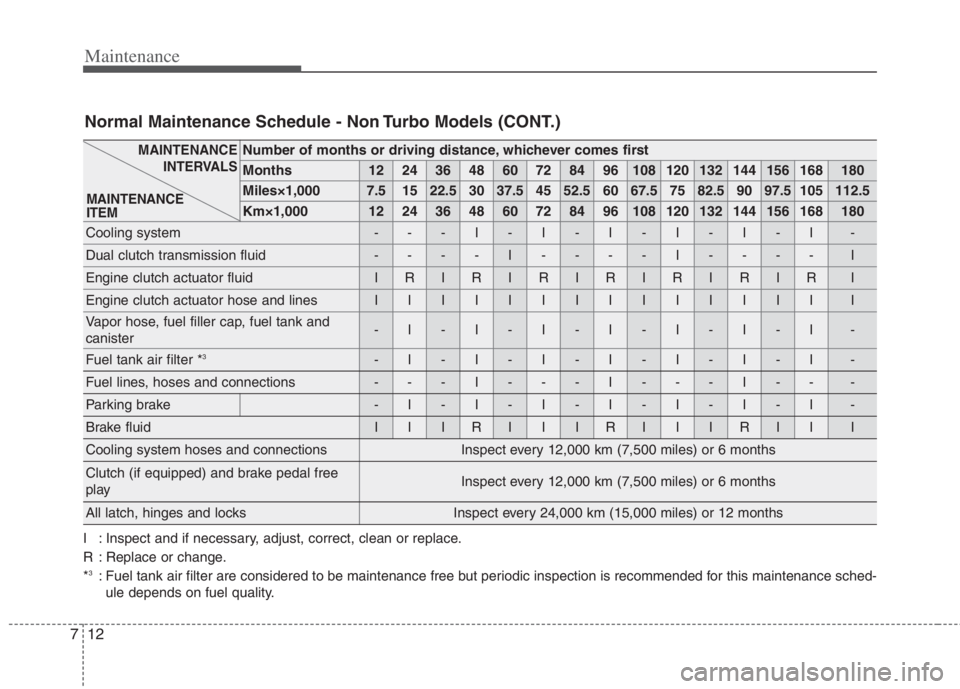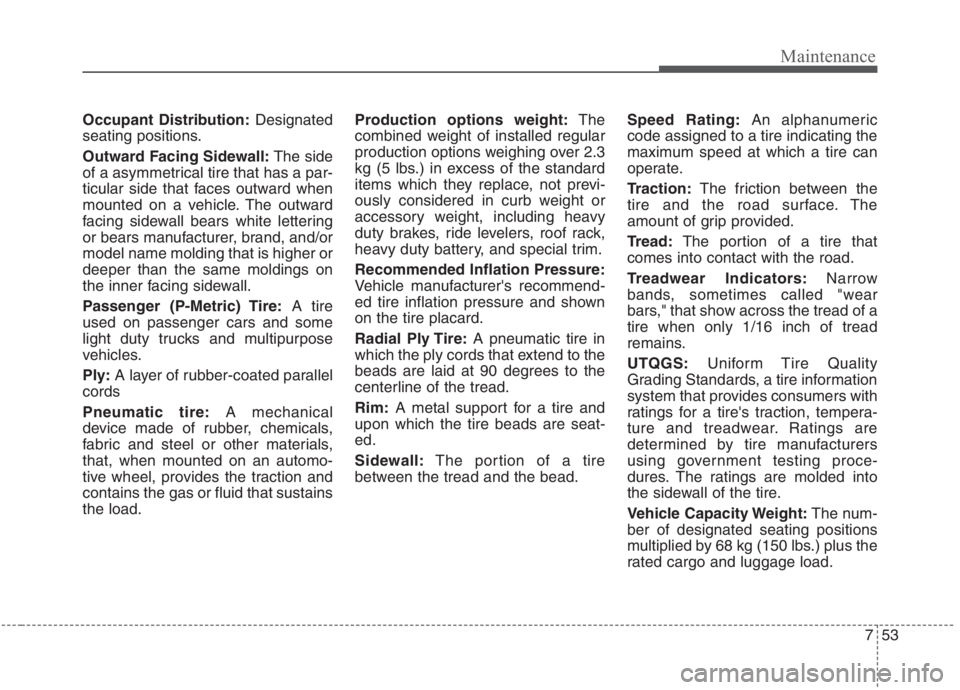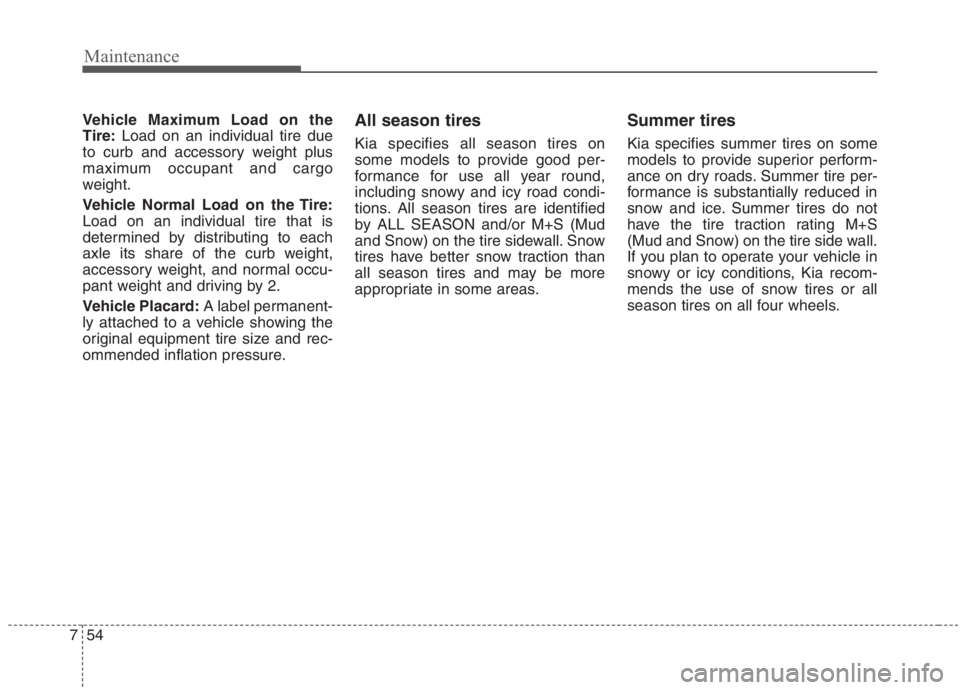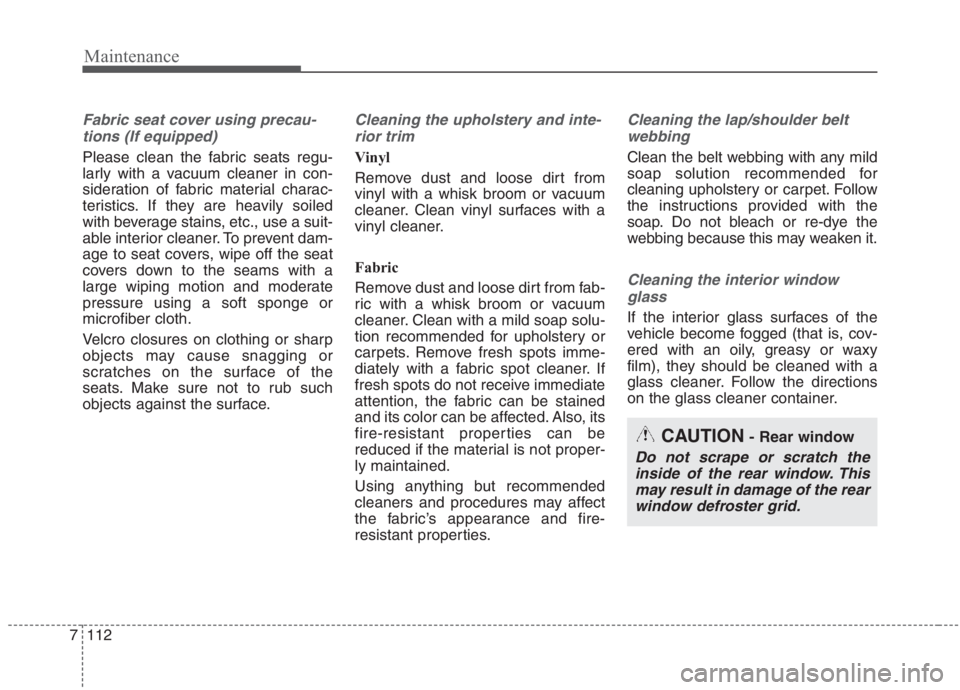2021 KIA NIRO HYBRID EV ECO mode
[x] Cancel search: ECO modePage 536 of 667

Maintenance
10
7
Normal Maintenance Schedule - Non Turbo Models
The following maintenance services must be performed to ensure good emission control and performance.
Keep receipts for all vehicle emission services to protect your warranty. Where both mileage and time are shown, the
frequency of service is determined by whichever occurs first.
Number of months or driving distance, whichever comes first
Months1224364860728496108120132144156168180
Miles×1,0007.51522.530 37.5 45 52.5 60 67.5 75 82.5 90 97.5 105 112.5
Km×1,00012 24 36 48 60 72 84 96 108 120 132 144 156 168 180
Engine oil and engine oil
filterKappa 1.6L GDIRRRRRRRRRRRRRRR
Fuel additives *1Add every 12,000 km (7,500 miles) or 12 months
Air cleaner filterIIIRIIIRIIIRIII
Spark plugsKappa 1.6L GDIReplace every 150,000 km (100,000 miles) or 120 months
HSG belt *2IIIRIIIRIIIRIII
Rotate tiresRotate every 12,000 km (7,500 miles)
Climate control air filter-R-R-R-R-R-R-R-
MAINTENANCE
INTERVALS
MAINTENANCE
ITEM
I : Inspect and if necessary, adjust, correct, clean or replace.
R : Replace or change.
*
1: If TOP TIER Detergent Gasoline is not available, one bottle of additive is recommended. Additives are available from your authorized Kia dealer along with information on how to use them. Do not mix other additives.
*
2: Inspect HSG belt for evidence of cuts, cracks, excessive wear or oil saturation and replace if necessary. If HSG belt noise occurred, readjust HSG belt tension before replace.
Page 538 of 667

Maintenance
12
7
Number of months or driving distance, whichever comes first
Months1224364860728496108120132144156168180
Miles×1,0007.51522.530 37.5 45 52.5 60 67.5 75 82.5 90 97.5 105 112.5
Km×1,00012 24 36 48 60 72 84 96 108 120 132 144 156 168 180
Cooling system---I-I-I-I-I-I-
Dual clutch transmission fluid----I----I----I
Engine clutch actuator fluidIRIRIRIRIRIRIRI
Engine clutch actuator hose and linesIIIIIIIIIIIIIII
Vapor hose, fuel filler cap, fuel tank and
canister-I-I-I-I-I-I-I-
Fuel tank air filter *3-I-I-I-I-I-I-I-
Fuel lines, hoses and connections---I---I---I---
Parking brake-I-I-I-I-I-I-I-
Brake fluidIIIRIIIRIIIRIII
Cooling system hoses and connectionsInspect every 12,000 km (7,500 miles) or 6 months
Clutch (if equipped) and brake pedal free
playInspect every 12,000 km (7,500 miles) or 6 months
All latch, hinges and locksInspect every 24,000 km (15,000 miles) or 12 months
MAINTENANCE
INTERVALS
MAINTENANCE
ITEM
Normal Maintenance Schedule - Non Turbo Models (CONT.)
I : Inspect and if necessary, adjust, correct, clean or replace.
R : Replace or change.
*
3: Fuel tank air filter are considered to be maintenance free but periodic inspection is recommended for this maintenance sched- ule depends on fuel quality.
Page 579 of 667

753
Maintenance
Occupant Distribution:Designated
seating positions.
Outward Facing Sidewall:The side
of a asymmetrical tire that has a par-
ticular side that faces outward when
mounted on a vehicle. The outward
facing sidewall bears white lettering
or bears manufacturer, brand, and/or
model name molding that is higher or
deeper than the same moldings on
the inner facing sidewall.
Passenger (P-Metric) Tire:A tire
used on passenger cars and some
light duty trucks and multipurpose
vehicles.
Ply:A layer of rubber-coated parallel
cords
Pneumatic tire:A mechanical
device made of rubber, chemicals,
fabric and steel or other materials,
that, when mounted on an automo-
tive wheel, provides the traction and
contains the gas or fluid that sustains
the load.Production options weight:The
combined weight of installed regular
production options weighing over 2.3
kg (5 lbs.) in excess of the standard
items which they replace, not previ-
ously considered in curb weight or
accessory weight, including heavy
duty brakes, ride levelers, roof rack,
heavy duty battery, and special trim.
Recommended Inflation Pressure:
Vehicle manufacturer's recommend-
ed tire inflation pressure and shown
on the tire placard.
Radial Ply Tire:A pneumatic tire in
which the ply cords that extend to the
beads are laid at 90 degrees to the
centerline of the tread.
Rim:A metal support for a tire and
upon which the tire beads are seat-
ed.
Sidewall:The portion of a tire
between the tread and the bead.Speed Rating:An alphanumeric
code assigned to a tire indicating the
maximum speed at which a tire can
operate.
Traction:The friction between the
tire and the road surface. The
amount of grip provided.
Tread:The portion of a tire that
comes into contact with the road.
Treadwear Indicators:Narrow
bands, sometimes called "wear
bars," that show across the tread of a
tire when only 1/16 inch of tread
remains.
UTQGS:Uniform Tire Quality
Grading Standards, a tire information
system that provides consumers with
ratings for a tire's traction, tempera-
ture and treadwear. Ratings are
determined by tire manufacturers
using government testing proce-
dures. The ratings are molded into
the sidewall of the tire.
Vehicle Capacity Weight:The num-
ber of designated seating positions
multiplied by 68 kg (150 lbs.) plus the
rated cargo and luggage load.
Page 580 of 667

Maintenance
54 7
Vehicle Maximum Load on the
Tire:Load on an individual tire due
to curb and accessory weight plus
maximum occupant and cargo
weight.
Vehicle Normal Load on the Tire:
Load on an individual tire that is
determined by distributing to each
axle its share of the curb weight,
accessory weight, and normal occu-
pant weight and driving by 2.
Vehicle Placard:A label permanent-
ly attached to a vehicle showing the
original equipment tire size and rec-
ommended inflation pressure.All season tires
Kia specifies all season tires on
some models to provide good per-
formance for use all year round,
including snowy and icy road condi-
tions. All season tires are identified
by ALL SEASON and/or M+S (Mud
and Snow) on the tire sidewall. Snow
tires have better snow traction than
all season tires and may be more
appropriate in some areas.
Summer tires
Kia specifies summer tires on some
models to provide superior perform-
ance on dry roads. Summer tire per-
formance is substantially reduced in
snow and ice. Summer tires do not
have the tire traction rating M+S
(Mud and Snow) on the tire side wall.
If you plan to operate your vehicle in
snowy or icy conditions, Kia recom-
mends the use of snow tires or all
season tires on all four wheels.
Page 638 of 667

Maintenance
112 7
Fabric seat cover using precau-
tions (If equipped)
Please clean the fabric seats regu-
larly with a vacuum cleaner in con-
sideration of fabric material charac-
teristics. If they are heavily soiled
with beverage stains, etc., use a suit-
able interior cleaner. To prevent dam-
age to seat covers, wipe off the seat
covers down to the seams with a
large wiping motion and moderate
pressure using a soft sponge or
microfiber cloth.
Velcro closures on clothing or sharp
objects may cause snagging or
scratches on the surface of the
seats. Make sure not to rub such
objects against the surface.
Cleaning the upholstery and inte-
rior trim
Vinyl
Remove dust and loose dirt from
vinyl with a whisk broom or vacuum
cleaner. Clean vinyl surfaces with a
vinyl cleaner.
Fabric
Remove dust and loose dirt from fab-
ric with a whisk broom or vacuum
cleaner. Clean with a mild soap solu-
tion recommended for upholstery or
carpets. Remove fresh spots imme-
diately with a fabric spot cleaner. If
fresh spots do not receive immediate
attention, the fabric can be stained
and its color can be affected. Also, its
fire-resistant properties can be
reduced if the material is not proper-
ly maintained.
Using anything but recommended
cleaners and procedures may affect
the fabric’s appearance and fire-
resistant properties.
Cleaning the lap/shoulder belt
webbing
Clean the belt webbing with any mild
soap solution recommended for
cleaning upholstery or carpet. Follow
the instructions provided with the
soap. Do not bleach or re-dye the
webbing because this may weaken it.
Cleaning the interior window
glass
If the interior glass surfaces of the
vehicle become fogged (that is, cov-
ered with an oily, greasy or waxy
film), they should be cleaned with a
glass cleaner. Follow the directions
on the glass cleaner container.
CAUTION- Rear window
Do not scrape or scratch the
inside of the rear window. This
may result in damage of the rear
window defroster grid.
Page 665 of 667

I9
Index
Smart Cruise Control (SCC). . . . . . . . . . . . . . . . . . . . 5-103
Detecting Sensor (front view camera/front radar) . 5-116
Limitations of the system . . . . . . . . . . . . . . . . . . . . 5-119
Set SCC Reaction . . . . . . . . . . . . . . . . . . . . . . . . . . 5-111
Smart cruise control switch . . . . . . . . . . . . . . . . . . 5-103
To convert to cruise control mode . . . . . . . . . . . . . 5-118
Vehicle to vehicle distance setting . . . . . . . . . . . . . 5-111
When the lane ahead is clear . . . . . . . . . . . . . . . . . 5-112
When there is a vehicle ahead of you in your lane. 5-113
Smart key . . . . . . . . . . . . . . . . . . . . . . . . . . . . . . . . . . . 4-11
Battery replacement . . . . . . . . . . . . . . . . . . . . . . . . . 4-15
Loss of the smart key . . . . . . . . . . . . . . . . . . . . . . . . 4-14
Mechanical key . . . . . . . . . . . . . . . . . . . . . . . . . . . . 4-14
Record your key number . . . . . . . . . . . . . . . . . . . . . 4-11
Smart key function . . . . . . . . . . . . . . . . . . . . . . . . . . 4-11
Smart key immobilizer system. . . . . . . . . . . . . . . . . 4-16
Smart key precautions . . . . . . . . . . . . . . . . . . . . . . . 4-14
Special driving conditions . . . . . . . . . . . . . . . . . . . . . 5-144
Driving at night . . . . . . . . . . . . . . . . . . . . . . . . . . . 5-147
Driving in flooded areas. . . . . . . . . . . . . . . . . . . . . 5-148
Driving in the rain . . . . . . . . . . . . . . . . . . . . . . . . . 5-147
Driving off-road . . . . . . . . . . . . . . . . . . . . . . . . . . . 5-148
Hazardous driving conditions . . . . . . . . . . . . . . . . 5-144
Highway driving . . . . . . . . . . . . . . . . . . . . . . . . . . . 5-148
Reducing the risk of a rollover. . . . . . . . . . . . . . . . 5-144
Rocking the vehicle . . . . . . . . . . . . . . . . . . . . . . . . 5-146
Smooth cornering . . . . . . . . . . . . . . . . . . . . . . . . . . 5-146Steering wheel . . . . . . . . . . . . . . . . . . . . . . . . . . . . . . . 4-47
Electric Power Steering (EPS) . . . . . . . . . . . . . . . . . 4-47
Heated steering wheel . . . . . . . . . . . . . . . . . . . . . . . 4-49
Horn . . . . . . . . . . . . . . . . . . . . . . . . . . . . . . . . . . . . . 4-50
Tilt and telescopic steering. . . . . . . . . . . . . . . . . . . . 4-48
Storage compartments . . . . . . . . . . . . . . . . . . . . . . . . 4-164
Center console storage . . . . . . . . . . . . . . . . . . . . . . 4-164
Glove box . . . . . . . . . . . . . . . . . . . . . . . . . . . . . . . . 4-164
Luggage box . . . . . . . . . . . . . . . . . . . . . . . . . . . . . . 4-166
Sunglass holder . . . . . . . . . . . . . . . . . . . . . . . . . . . 4-165
Sunroof . . . . . . . . . . . . . . . . . . . . . . . . . . . . . . . . . . . . . 4-42
Resetting the sunroof . . . . . . . . . . . . . . . . . . . . . . . . 4-45
Sliding the sunroof . . . . . . . . . . . . . . . . . . . . . . . . . . 4-43
Sunroof open warning . . . . . . . . . . . . . . . . . . . . . . . 4-46
Sunshade. . . . . . . . . . . . . . . . . . . . . . . . . . . . . . . . . . 4-45
Tilting the sunroof . . . . . . . . . . . . . . . . . . . . . . . . . . 4-44
Theft-alarm system . . . . . . . . . . . . . . . . . . . . . . . . . . . . 4-18
Armed stage . . . . . . . . . . . . . . . . . . . . . . . . . . . . . . . 4-18
Disarmed stage . . . . . . . . . . . . . . . . . . . . . . . . . . . . . 4-20
Theft-alarm stage . . . . . . . . . . . . . . . . . . . . . . . . . . . 4-19
Tire Pressure Monitoring System (TPMS) . . . . . . . . . . 6-13
Changing a tire with TPMS . . . . . . . . . . . . . . . . . . . 6-17
Check tire pressure . . . . . . . . . . . . . . . . . . . . . . . . . . 6-13
Low tire pressure position telltale . . . . . . . . . . . . . . 6-15
Low tire pressure telltale . . . . . . . . . . . . . . . . . . . . . 6-15
T